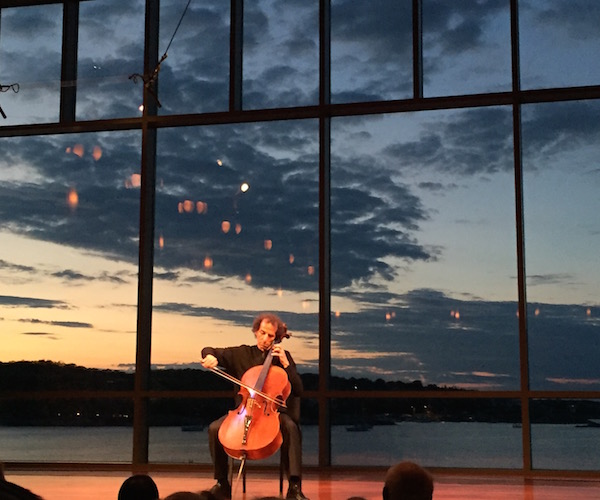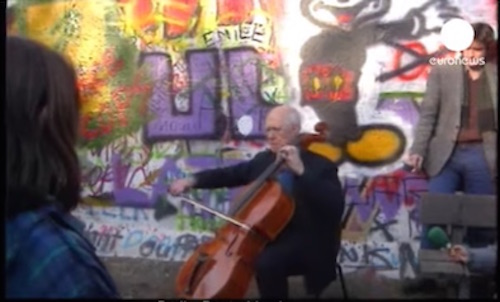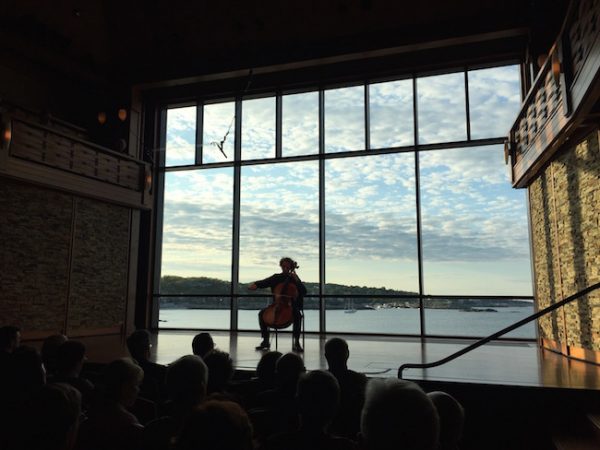Reflections and Echoes: Colin Carr Plays the Complete Bach Cello Suites
Now I must pluck up courage and record all the Bach suites …
-Mstislav Rostropovich

As Colin Carr played, the light over the water faded … Photo: Eric Fishman
By Eric Fishman
Reviewing someone’s performance of J.S. Bach’s six suites for solo cello feels a bit like passing judgement on their soul: not to be taken lightly. What about the suites makes them feel this monumental?
If we imagine characters of music to be individual flora and fauna, the suites are a lush rainforest ecosystem, teeming with variegation. Recoding or performing the complete suites calls upon a musician’s emotional and interpretive range in ways few other pieces of classical music can.
The suites are also impossible music. Bach has written polyphonic, contrapuntal music — music with three to four voices — for an instrument that can play only one line at a time. A cellist’s ability to conjure these multiple voices for the audience is one of the foundations of a great performance of the suites. There is a single cellist on stage, but more than one cello must sing through the music.
The historical story of the suites also has an appealing “underdog” trajectory to it. The suites were composed by Bach in his period as the capellmeister in the rural, out-of-fashion court of Prince Leopold in Cöthen. The fact that these were written for the violoncello is fairly astonishing, given the instrument’s past relegation to an accompaniment instrument. (The sixth suite is written for the five-stringed violoncello piccolo, a roughly 7/8 sized cello with an upper string tuned to E.) Seventeenth century audiences would have found the idea of a “cello virtuoso” to be absurd. For over a century after they were written, the suites were considered mere practice aids, until — as legend has it — Spanish cellist Pablo Casals discovered a copy in a dusty music shop in the late 1800s, and spent the rest of his life championing them.
For all of these reasons and others, the Bach cello suites have carved out a major place for themselves in the canon of classical music. Practically every major cellist of the past fifty years has released at least one version of the suites (or, in the case of Janos Starker, a recording each time he signed with a new record label). Rostropovich played the suites as the Berlin Wall fell. Yo-Yo Ma played a movement from the suites at the one year memorial service for the victims of September 11.
At times it feels impossible to get away from the suites: nearly every conservatory or festival audition for cellists requires Bach. A search of Spotify reveals arrangements of the suites for lute, saxophone, recorder, guitar, and mandolin. Cellists have played the suites surrounded by dancers (Jean-Guihen Queyras), in diners on the side of the highway (Matt Haimovitz), and with ice skaters (Yo-Yo Ma). The suites are also what inspired my father to pick up the cello in his late fifties, and practice nearly daily despite slow progress.

Rostropovich plays the Bach Suites at the fall of the Berlin Wall. Source: You Tube.
All of this history was in my head when I drove north on July 12 to hear the British cellist Colin Carr perform the complete suites at the Rockport Chamber Music Festival. Carr, who released a recording of the complete suites last year, is an intriguing cellist to watch. His eyes were closed or downcast for almost the entire three hour performance, as if he were playing for himself. Occasionally he gave a sly smile, amused by one of his own choices. His eyebrows, however, had a life of their own, wiggling and waggling with the contours of the music. The scenic aspect of the performance was further enhanced by the view through the stage-to-ceiling windows: a slow sunset over the bay.
Passing judgement on someone’s performance of the suites is not trivial. The central “mystery” of the suites is that there are no copies of Bach’s original manuscript. Musicians must therefore rely on secondhand transcriptions by Bach’s second wife Anna Magdelena and the organist Johann Peter Kellner. Because there is no “authoritative” source for interpretive questions such as articulation and dynamics, many of these choices are left up to cellists. The sheer number of decisions required in order to perform the suites boggles the mind: tempo, articulation, tone, phrase length and direction, dynamics, the overall character. Do you use a baroque bow, instrument, or strings — or modern ones? And finally: how to make the music feel like dance music? These are, after all, suites of dances — six suites, with six movements each: a prelude, followed by an allemande, a courante, a sarabande, a pair of gavottes or minuets or bourrées, and a final gigue. Each of these dance forms has its own complicated history.
In order to help illuminate some of the variations in performance that exist, I’d like to contrast three interpretations of one moment in the suites: the opening two-and-a-half measure phrase of the prelude to the fifth suite, in c minor. I recommend you listen to these opening bars on a recording as you read. The first two are available on YouTube, and Carr’s recorded version is available on Spotify.

The first lines of the fifth suite, in Anna Magdelena Bach’s manuscript. Source: IMSLP Petrucci Music Library.
First: Rostropovich. The fifth prelude opens with octave C’s like a gunshot: a sharp consonant attack, slowly fading. The ascending line that follows is heavy, building back up. He breaks the last two sixteenth notes of this line into two bows, sounding even more deliberate. For the chord that begins measure two, Rostropovich chooses to avoid the A string and its brighter color, instead shifting up on the D and G strings to complete the chord. His vibrato is thick, his sound and articulation weighty, in the vein of what one would expect in an interpretation of a Romantic composer such as Brahms. There is so much anguish and suffering here, fully on display.
Next: Pieter Wispelwey, the Dutch cellist known for his unusual interpretations of the suites. If you move from Rostropovich’s recording to this one, the first note will likely be a surprise: Wispelwey has tuned to a baroque A, significantly flatter than the modern one. His beginning consonant is a gentler one, and the sound swells slowly up and then fades, a gentle curve that pulls you in. The sixteenth run that follows is also a surprise: Wispelwey accelerates dramatically through the ascending line, treating it more like an ornamentation of the chord that follows. He uses almost no vibrato. There is also much more air between notes, as Wispelwey follows baroque conventions for slurring and spacing. The result is lighter, more muted. This is an entirely different tonal universe: if Rostropovich is weeping and rending his hair on a granite mountain, Wispelwey is crying softly in a darkened barn, as he wheels and turns about, with candles flickering over the walls.

Now, for Carr’s live performance of the opening of the fifth suite, in Rockport. His interpretation took the “openwork” of Whispelwey’s approach even further. He played notes that Whispelwey played détaché almost staccato. His dynamic and tempo shifts were more predictable than Whispelwey’s — topographically, this was a mountain range from the East Coast, not the West. Although there were not be as many “surprise vistas,” its regularity made it feel like a line to which one could dance. At one point in the gigue of third suite, I looked to one side and saw an elderly lady bobbing her head in time, aggressively flinging her poof of white curls back and forth: an excellent sign of Carr’s rhythmic integrity.
Throughout the suites, Carr employed a light sound, bowing up towards the fingerboard. One could hear the grassy texture of his bow hair — grassy, almost ponticello at times. His elegant approach to phrasing was particularly effective in the third suite, such as in his deliciously clean execution of the arpeggiated sequence in the prelude. One could hear each line clearly. In the baroque tradition, Carr added his own occasional ornamentations and flourishes. I appreciated his subtle shifts in color and tone.
There were also times when I felt his approach was less effective. In the sarabande of the second suite, for example, Carr’s tone felt harsh, almost brittle. He left so much space between notes that the phrase felt fragmented, confused. This sense of disorientation recurred occasionally. I also wished for greater dynamic contrasts throughout. The furthest seats in Shalin Liu hall must have been no more than a hundred feet from the stage. What delicate pianissimos Carr could have used, and we would still have been able to hear him! Overall, though, this was classy cello playing. Carr relied on, and brought out, the inherent architecture of the suites.
As Carr played, the light over the water faded. During the prelude of the fifth suite, a fishing boat passed by, its light slowly rotating. The occasional beam of light shone into the hall, echoing the glimpses of brightness in Bach’s desolate landscape. Then: total darkness. A reflection coalesced in the window. A ghostly audience, sitting over the water. A cellist’s back, playing Bach. The tide rose to cover the shore.

Eric Fishman is an elementary school teacher, writer, translator, and cellist. He studied cello at Yale School of Music and Conservatoire de Paris.
